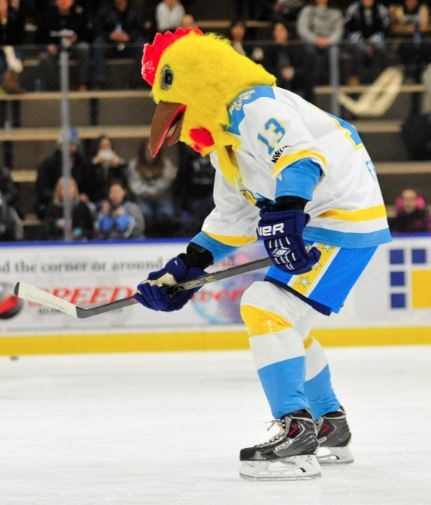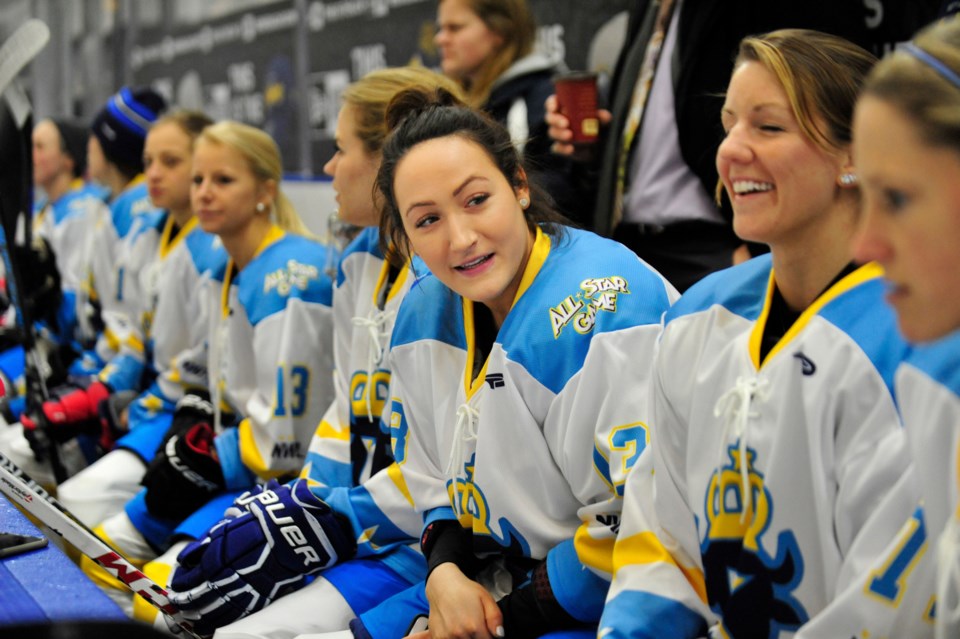One of the best hockey players to come out of B.C., Kaleigh Fratkin is a Canadian prospect who you’ve probably never heard of.
The 23-year-old, Burnaby-raised defender plays for the Connecticut Whale in the inaugural season of the four-team National Women’s Hockey League (NWHL), which also features the Boston Pride, Buffalo Beauts and New York Riveters. Media coverage of the league and its highest-paid Canadian player is hard to find.
For Fratkin, reaching a higher level has meant piling up points for the Whale, who have 24 points behind the league-leading Pride with 27. Through 16 games, Fratkin has notched five goals and 12 assists to lead all NWHL defenders and sits tied for sixth in overall points. She also tops the league with 38 penalty minutes.
Her outstanding play earned her a trip to the NWHL All-Star game on Jan. 24 in Buffalo.
In the skills competition the night before, Fratkin endeared herself to fans in a completely hilarious, completely original way. She wore her Whale sweater along with a giant, stuffed chicken head.
“I competed in the hardest shot competition,” Fratkin said. “Let’s just say it was really hard to look out of that chicken head. I lost sight of the puck when I went to shoot, so I’m glad I just hit it. I believe the shot recorded as 77 miles per hour.”

Fratkin said her development as a hockey player would not have been possible without access to rinks, teams and minor hockey programs in Vancouver. The Vancouver North West Giants is one of the many teams Fratkin remembers playing with at Britannia and Hastings Community Centre arenas.
“Vancouver hockey had a big influence on my playing career,” she said over the phone from Norwalk, Connecticut. “Vancouver is a hockey hotbed. There are hockey rinks located all over and the resources to grow and develop as a player are abundant. I think because I had access to so many rinks and different resources that I may not have had the access to if I didn’t live in Vancouver, I’m not sure I would have been able to develop as a player to propel me on to higher levels.”
It’s been an exciting time for Fratkin who also participated in the NHL’s Outdoor Women’s Classic at Gillette Stadium Dec. 31 after the Pride needed players to fill roster spots vacated by U.S. national team players who were not released from training camp. Living in Massachusetts, the 2014 Boston University graduate has grown to love sports clubs in a city that many Vancouverites have come to hate. Playing in the Women’s Classic was a once-in-a-lifetime opportunity she won’t soon forget.
“That was an unbelievable experience. It was very short-lived — I wish I could do that all the time,” said Fratkin, a confessed Patriots fan. “That was my first time at Gillette. Growing up as a hockey player, you play outside. Being able to do that at Gillette, at a pretty iconic venue, is special. I took the time to look around and soak it all in.”
Appearing in the Women’s Classic and playing in the NWHL All-Star game almost didn’t come to fruition. This past offseason, Fratkin had a big decision to make: She could stay in the Canadian Women’s Hockey League with the Boston Blades or take a chance on a new league. The risk was worth it.
“The biggest thing for me, as a player, when you get to another level and you’re done college… When you get to the age of the 23, you want to be playing hockey and playing at a top end level, and I’d have to get a job at the same time,” she said.
The off-season didn’t just present Fratkin with a choice. The talent pool was suddenly divided between the CWHL, which launched in the 2007-08 season, and the upstart NWHL, which announced itself as the first hockey league on the continent to pay women.
Each NWHL team has a $270,000 salary cap, and the minimum annual salary is $10,000. (All currencies U.S. dollars.)
Fratkin will make $20,000 this season as the highest-paid Canadian among her 17 compatriots in the NWHL. The top salaries of $25,000 is paid to Kelli Stack, and individual players earn proceeds from their jersey sales. The salaries are listed publicly here.
While it’s not enough to make a living, it’s better than nothing. She also coaches hockey and offers private lessons in Connecticut.
“I want to train and [want] it to be my job. I wasn’t getting paid in the CWHL. For me it just seemed more realistic to play hockey as your job. It was a no-brainer. When that was put in front of me, I thought it would be absolutely foolish to turn that down,” she said.
In her case, and for most professional players in the NWHL, Fratkin said stability is an important factor. All four teams are owned by the league, but as the playoffs are set to begin next month, the future of a second season is unknown.
One possible step is to the two leagues, but NWHL spokesman Jake Duhaime was non-committal.
“We saw the power of collaboration with the NHL’s Outdoor Women’s Classic,” he said. “Though with limited resources and being fully in-season, both leagues are focused on their own operational goals and objectives at the moment.”
Fratkin should continue to pile up points for Connecticut as the Whale hope to hoist the Isobel Cup next month. She hopes to see a partnership or merger that will eventually benefit future generations of athletes by paying them to play. In the meantime, players will have to choose one way or the other — as she did.
“You hope that there’s some sort of adjustment,” she said, noting the pioneers who for years pursued their passion without a paycheque. “It’s going to be hard for one league that doesn’t pay players and one that does. I don’t know how players can play for so long without being paid.”
Events such as the NHL’s Outdoor Women’s Classic and NWHL All-Star game are important, but the light they shine may not be bright enough for women’s hockey to grow and succeed over the long term.
For now, players like Fratkin will wait and see if the NWHL and CWHL can come together, giving women and girls the opportunity to earn a salary and play the sport they first discovered in minor hockey rinks in their hometown.
Twitter: @HarJournalist



